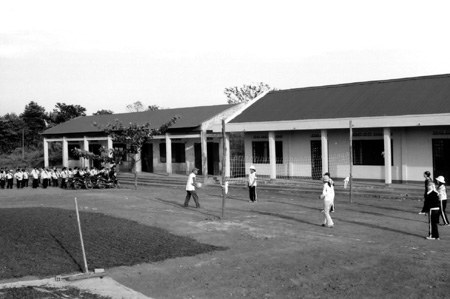Ethnic students prepare for school with language lessons
Starting this year, all preschool-age children from ethnic minority groups in the Central Highlands province of Dak Nong will be taught Vietnamese before entering first grade, according to the provincial People’s Council.
Primary students will have four sessions of Vietnamese language lessons every week, as will secondary students who perform poorly.
To achieve this goal, the province plans to raise the number of teachers who themselves come from ethnic minority groups to 10 per cent in 2016, from nearly 9 per cent this year. All primary school teachers will also have fluent knowledge of M’Nong and E-de, the two main languages spoken by the province’s ethnic people.
Teachers will receive an allowance equal to 4 per cent of the minimum wage for teaching language skills on weekends. Funding for lessons during the week will total VND100,000 ($4.7) per student per month.
Nguyen Van Hoa, deputy director of the provincial Department of Education and Training, said that the inability to speak and write Vietnamese, as well as parental ignorance about their children’s studies, were among the biggest obstacles when it came to educating ethnic minority children.
“Many schools in disadvantaged areas have organised free summer lessons for preschool students and students who are entering first grade so they can familiarise themselves with Vietnamese and be better prepared for the following school year,” he said. “However, many parents prefer to keep their kids at home, even when teachers come to encourage them to let them go to class.”
The parents of H’Mong children - the fourth most common ethnic group in the province – were often illiterate and failed to encourage their children to go to school, Hoa said. Compounding the problem, about 10 per cent of ethnic minorities lived in isolated areas far from schools.
The department is offering classes for teachers to study the M’Nong and H’Mong languages to help them reach out to students and their families. The director also suggested creating a fund for schools to build more classrooms – as well as kitchens.
“Students will surely go to school regularly and diligently when their parents don’t have to think about their everyday meals,” he said.
This academic year, there are more than 48,450 ethnic minority students - an increase of 1,350 students compared to the previous year. They account for 33.2 per cent of all students in the province.

The newly-built No Trang Buy Primary School in Gia Nghia Town is one of
246 projects built by Government Programme 135 in efforts to facilitate
local children to enter first grade in Dak Nong Province.
According to a resolution recently approved by the council, more than 90 per cent of children under five belonging to the M’Nong, Ma, E-de and H’Mong groups will be enrolled in pre-school in the 2013-16 period. About 80 per cent of them will study Vietnamese for two sessions per day so they can be better prepared for primary school.Primary students will have four sessions of Vietnamese language lessons every week, as will secondary students who perform poorly.
To achieve this goal, the province plans to raise the number of teachers who themselves come from ethnic minority groups to 10 per cent in 2016, from nearly 9 per cent this year. All primary school teachers will also have fluent knowledge of M’Nong and E-de, the two main languages spoken by the province’s ethnic people.
Teachers will receive an allowance equal to 4 per cent of the minimum wage for teaching language skills on weekends. Funding for lessons during the week will total VND100,000 ($4.7) per student per month.
Nguyen Van Hoa, deputy director of the provincial Department of Education and Training, said that the inability to speak and write Vietnamese, as well as parental ignorance about their children’s studies, were among the biggest obstacles when it came to educating ethnic minority children.
“Many schools in disadvantaged areas have organised free summer lessons for preschool students and students who are entering first grade so they can familiarise themselves with Vietnamese and be better prepared for the following school year,” he said. “However, many parents prefer to keep their kids at home, even when teachers come to encourage them to let them go to class.”
The parents of H’Mong children - the fourth most common ethnic group in the province – were often illiterate and failed to encourage their children to go to school, Hoa said. Compounding the problem, about 10 per cent of ethnic minorities lived in isolated areas far from schools.
The department is offering classes for teachers to study the M’Nong and H’Mong languages to help them reach out to students and their families. The director also suggested creating a fund for schools to build more classrooms – as well as kitchens.
“Students will surely go to school regularly and diligently when their parents don’t have to think about their everyday meals,” he said.
This academic year, there are more than 48,450 ethnic minority students - an increase of 1,350 students compared to the previous year. They account for 33.2 per cent of all students in the province.

Leave your comment on this story